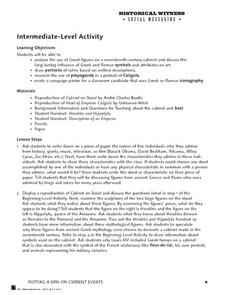Curated OER
An Interview With the Past: Ancient Roman and U.S. Government Leaders
Students produce a modern television interview show where they present information about Ancient Rome and its influence on modern governments. In this governments lesson plan, students produce shows in groups.
Curated OER
Leader of the Pack
Students take a closer look the 2008 London mayoral race. In this current events lesson, students research the listed Web sites that include information about the candidates for mayor and their attributes. Students also gather...
Curated OER
Child Labor and Social Protest
Students explore child labor of the 1900's and compare it to its existence in countries around the world today. Several activities are included including Web research, video presentations, and group projects.
Curated OER
Social Studies, Civics Lesson
Students examine the development of government. They identify different theories of political thought around the world. They participate in a play to discover their own political views on key issues.
Albert Shanker Institute
Economic Causes of the March on Washington
Money can't buy happiness, but it can put food on the table and pay the bills. The first of a five-lesson unit teaches pupils about the unemployment rate in 1963 and its relationship with the March on Washington. They learn how to create...
Curated OER
Connected Educators Month
Education and thought leaders join forces to provide invigorating professional opportunities online.
Curated OER
Honoring Leaders
Students design and compare monuments that honor an imaginary Roman emperor and a future American president. They explain how the monuments reflect the attributes of the person being honored.
Dick Blick Art Materials
Simple Suminagashi
Go ahead. Spill the ink! Combine the study of art, social studies, and science with a Suminagashi (spilled ink) activity that produces "unique and unreproducible" works of art.
Fluence Learning
Writing an Argument: Innovation in America
Are American young people prepared to become tomorrow's leaders in technological innovation, or does an obsession with being cool sidetrack essential skills? That is the question freshmen and sophomores must address in a performance task...
Curated OER
Early America
Students identify men and women who are leaders in their community and in the world at large. For this character traits lesson, students examine leaders of the past (Washington, Jefferson, Revere) and determine how each of these men...
Curated OER
The Civil War
In this Civil War worksheet, learners identify, locate and discuss thirty-five key terms, characters and leaders associated with The Civil War. Students circle each one in a word search puzzle.
Curated OER
Thomas Jefferson
Students explore the accomplishments of world leaders. In this Thomas Jefferson activity, students list the accomplishments achieved by Jefferson and read his epitaph. Students then write epitaphs for recent world leaders or celebrities.
Curated OER
Campaign! The Election Simulation Game
Students simulate the election process with one group acting as politicians and others acting as the constituency with concerns specific to their assigned area of the country. They give speeches, take polls, and elect a leader based on...
Curated OER
Abolishing Slavery
Students explain the goals and methods of the abolitionist movement.
They identify key leaders in the movement. This lesson has adaptations for elementary through high school. Links are provided for resource readings.
Curated OER
Jackie Robinson and Civil Rights
Students complete a worksheet and study key vocabulary while researching the biography of Jackie Robinson and the Civil Rights Movement. They chose another Civil Rights leader to investigate and present to the rest of the class before...
Curated OER
The Civil War
Learners explore the Civil War. Using computer technology, they create informational flash cards about the Civil War. Students use artwork to depict Civil War activities. They examine topics such as battles, leaders, tactics, prisoner of...
Curated OER
The People of the Civil War
Fifth graders complete a two week unit on the American Civil War. They complete a Venn diagram, watch a video, make butter, write journal entries, write a letter to a Civil War leader, and create a newspaper.
Curated OER
The Evolution of Congress
Using the Internet, as well as textbooks, high school scholars research how Congress has evolved over the years. They examine legislative leaders and their accomplishments, compare and contrast legislative procedures in various eras, and...
Curated OER
D-Day: June 6, 1944
Students examine the preparations for the invasion of France on June 6, 1944. After viewing a clip from "The War", they identify the demands and concerns of all military leaders for this invasion. They use maps to examine the...
Curated OER
Greek and Roman Symbolism
Students explore Greek and Roman symbolism in art. In this visual art lesson, students draw portraits of ancient leaders based on the written descriptions they read about them. Students also design campaign posters using Greek or Roman...
Curated OER
Design of Our Own
Students explore the concept of philanthropy. In this service learning lesson, students recognize family, school, and local community leaders who have contributed to the common good. Students also study community foundations.
Curated OER
A Contract on Bullying
If you want to stop bullying, you need to understand it. A four-part lesson guides learners through defining characteristics of a bully, identifying instances of bullying in the media and in their lives, and signing a contract to become...
Facing History and Ourselves
Eyes on the Prize Lesson 1: The Philosophy of Nonviolence
Learners explore the concept of nonviolent demonstration. In this Civil Rights Movement activity, students investigate examples of injustice and discuss the philosophy of nonviolence fueled by leaders of the movement. Learners apply...
Curated OER
Cartoons for the Classroom: Freedom is not Universal
In this current events instructional activity, students analyze political cartoons that feature caricatures of political leaders that have been challenged. Students respond to 3 talking point questions.

























